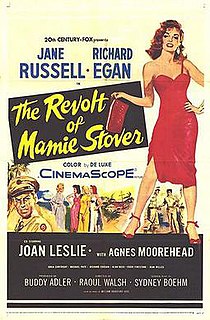
Mamie Smith was an American vaudeville singer, dancer, pianist and actress. As a vaudeville singer she performed in various styles, including jazz and blues. In 1920, she entered blues history as the first African-American artist to make vocal blues recordings. Willie "The Lion" Smith described the background of that recording in his autobiography, Music on My Mind (1964).

Mamie Van Doren is an American actress, model, singer, and sex symbol who is known for being one of the first actresses to imitate the look of Marilyn Monroe. Van Doren is perhaps best remembered for the rock 'n' roll, juvenile delinquency exploitation movie Untamed Youth (1957), and other films of this calibre.
Tess or TESS may refer to:
Zack or Zach may refer to:
"Mammy" is a nickname for a mother, used in several English dialects, including Hiberno-English used in Ireland.

The 1982 Pacific typhoon season had no official bounds; it ran year-round in 1982. On average, most tropical cyclones tend to form in the northwestern Pacific Ocean between May and November. These dates conventionally delimit the period of each year when most tropical cyclones form in the northwestern Pacific Ocean. The scope of this article is limited to the Pacific Ocean, north of the equator and west of the International Date Line. Storms that form east of the date line and north of the equator are called hurricanes.

The 1957 Pacific typhoon season has no official bounds; it ran year-round in 1957, but most tropical cyclones tend to form in the northwestern Pacific Ocean between June and December. These dates conventionally delimit the period of each year when most tropical cyclones form in the northwestern Pacific Ocean.

The Revolt of Mamie Stover is a 1956 romantic drama DeLuxe Color film directed by Raoul Walsh and produced by Buddy Adler from a screenplay by Sydney Boehm, based on the novel of the same name by William Bradford Huie. The picture stars Jane Russell and Richard Egan, with Joan Leslie, Agnes Moorehead, and Michael Pate, and was filmed in CinemaScope. The music was by Hugo Friedhofer and the cinematography by Leo Tover, with costume design by Travilla.

Mary Willa "Mamie" Gummer is an American actress. She starred in the title role of The CW series Emily Owens, M.D. (2012–13), and played the recurring role of Nancy Crozier on The Good Wife (2010–15) and its spin-off, The Good Fight (2018). She has also appeared in the films Evening (2007), Side Effects (2013), Cake (2014), and Ricki and the Flash (2015). She was nominated for the 2016 Drama Desk Award for Outstanding Actress in a Play for the original production of Ugly Lies the Bone.
Typhoon or Tropical Storm Mamie may refer to the following Pacific Ocean typhoons and storms:

Guns, Girls and Gangsters is a 1959 American film noir crime film directed by Edward L. Cahn starring Mamie Van Doren, Gerald Mohr, Lee Van Cleef and Grant Richards.

Typhoon Mamie was the worst tropical cyclone to affect northeastern China in 26 years. Originating from an area of disturbed weather near the Philippines in mid-August 1985, the system gradually became better organized, and was upgraded into a tropical storm early on August 16. It continued to deepen, and late on August 17, Mamie attained typhoon intensity. Around this time, Typhoon Mamie reached its peak intensity of 120 km/h (75 mph), which it maintained for 12 hours. After making landfall in Shanghai, the storm steadily weakened. However, after turning north and crossing the Shanghai Peninsula and the Yellow Sea, Mamie made a second landfall near Yantai as a tropical storm. After turning northwest and re-entering the Yellow Sea, Mamie moved ashore for the third and final time near Dairen. On August 21, Mamie dissipated inland over northeastern China.
This page is based on this
Wikipedia article Text is available under the
CC BY-SA 4.0 license; additional terms may apply.
Images, videos and audio are available under their respective licenses.







